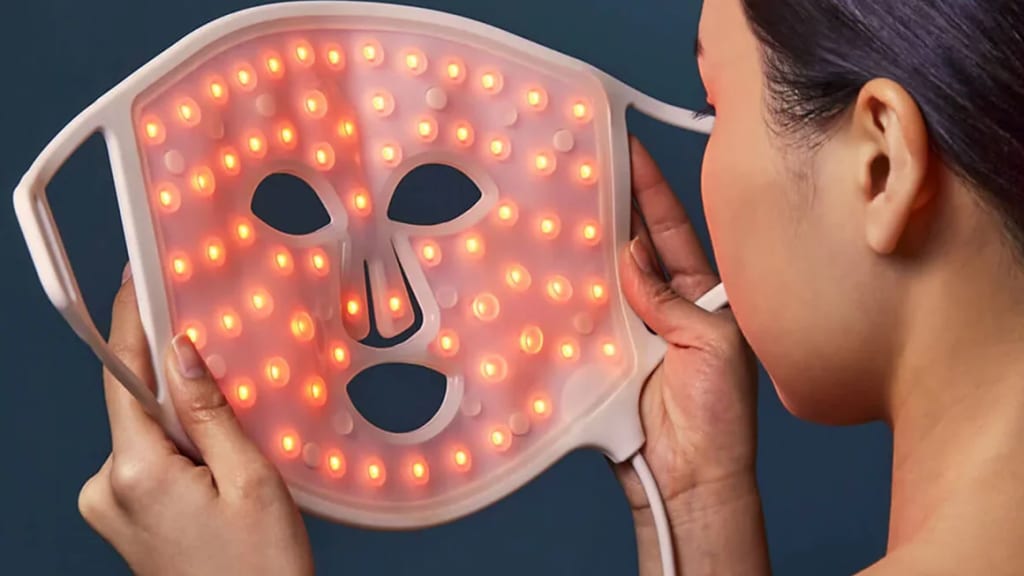What is red light therapy for the skin? Experts explain the anti-aging benefits.
Beauty / Skin Care

Nowadays, it seems like skincare and beauty enthusiasts are willing to try nearly anything to achieve that perfect glow. From gua shua massages to wrinkle patches, there are a myriad of intriguing, and sometimes strange, solutions on the market to address every skin and wellness concern.
In addition to tried-and-true serums and moisturizers, one of the latest innovative treatments is red light therapy. Available in a variety of devices like portable wands, lamps, masks, and more, red light therapy is a go-to amongst dermatologists and A-list clients like Chrissy Teigen and Kate Hudson.
“Red light therapy is a non-invasive treatment that uses low-level red light to improve the health and appearance of the skin,” explains Tyler Fish, co-founder of Sun Home Sauna. “Also known as photobiomodulation, it penetrates the skin at a cellular level [and] stimulates the production of collagen and elastin, which are essential proteins for healthy skin.”
Benefits of red-light therapy
“As gimmicky as these devices may seem, and seemed to me at first, the technology and science behind them are sound,” says board-certified dermatologist Dr. Luke Maxfield. The photo biomodulation that Fish mentioned creates biological action within the skin and has a therapeutic effect, Maxfield explains. This occurs when the LED (light emitting diodes) comes in close range of the skin, allowing the wavelengths of light to penetrate.
Varying wavelengths correlate to a specific color, each of which has different benefits. In addition to red, there is also blue, yellow, green, and near-infrared light therapy. The main difference between these colors is how each penetrates the skin — blue affects the outermost layer and helps to treat acne-causing bacteria, while near-infrared penetrates the deepest of all. While there are benefits to each, red and blue light therapy are most commonly used to address concerns like acne, wrinkles, and scarring.
“Of all the colors that make up this spectrum, red light has become a cornerstone of LED therapy,” Maxfield says. “Red light, due to the longer wavelength, penetrates deep within the skin. When reaching the dermis, it has been shown to benefit aging skin through activating fibroblasts, modulating inflammation, and even moderating sebum or oil production.”
Red light therapy is also used throughout the body for various reasons — often to treat wounds and to promote hair growth amongst those who have alopecia.
“By improving cellular function, red light therapy has been shown to increase the production of collagen [and] help with skin tone and texture as well as fine lines and wrinkles,” explains Dr. Tiffany J. Libby, board-certified dermatologist and director of Mohs micrographic and dermatologic surgery at Brown University. “Studies also show improvement in acne by calming redness and inflammation.”
Risks of red-light therapy
Although red light therapy is safe and noninvasive, the level of light used mustn't be too harsh. Most at-home devices have instructions dictating the frequency and amount of light to use, but one should always consult a dermatologist if necessary. It is also important to avoid any harsh treatments directly after red light therapy and to continue with daily SPF usage, as the treatment may leave the skin sensitive to UV radiation.
While red light therapy has been around for decades, it is still an emerging treatment — and the efficacy of at-home devices can vary. Though it has proven benefits and is entirely safe to use on the skin in moderation, like many treatments, it is important to monitor your skin’s reaction and adjust your routine accordingly.
“If the red light is at too high of a level, it damages skin cells. If at too low of a level, it does nothing,” explains Dr. Brandish Irwin, board-certified dermatologist and founder of skintour.com and Concierge Dermatology & Laser in Seattle, Washington. “Low-level home devices appear to be safe, except for possible aggravation of pigment problems. If your skin is not showing any signs of stress, in my opinion, continue for two months and then stop if you’re seeing no positive changes.”
How to use red light therapy
Red light therapy devices like masks and wands are most common. They make it easy to incorporate the treatment into your skincare routine.
“Cleanse skin before red light therapy so that no makeup or sunscreen is on the face,” Libby says. “Apply your serums and moisturizers following.” With treatment times ranging from three to 15 minutes, it offers a quick moment of relaxation and rejuvenation.
About the Creator
Anis Ahmed Siddeque
Hello, I am a professional Article writer. Before article writing was my hobby. On many social sites, I published various blogs and articles. Now, I have decided that the Article is a nice carrier. Before death, I want to earn money.






Comments
There are no comments for this story
Be the first to respond and start the conversation.